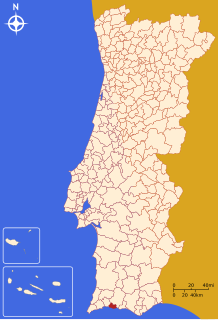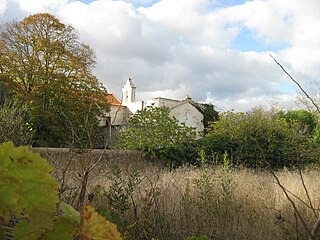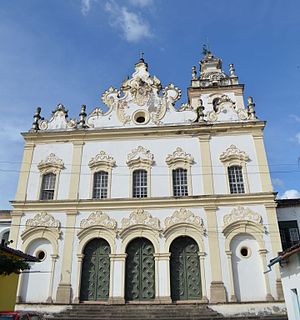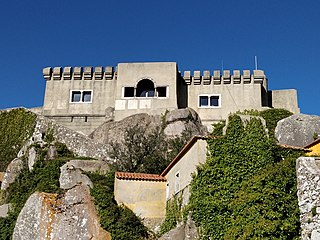
Vila do Porto is the single municipality, the name of the main town and one of the civil parishes on the island of Santa Maria, in the Portuguese archipelago of Azores. Its nearest neighbor, administratively, is the municipality of Povoação on the southern coast of São Miguel, and it is physically southwest of the islets of the Formigas. The population in 2011 was 5,552, in an area of 96.89 km².

São José is a civil parish in the municipality of Ponta Delgada on the island of São Miguel in the Portuguese archipelago of the Azores. It is one of the constituent parts of the city of Ponta Delgada, and location of many of the island's more significant cultural and historical, commercial and residential buildings. Extending a short distance along the coast it, nevertheless includes a large mixed urban-rural constituency from the shore north to the main freeway, the Via-Rápida. The population in 2011 was 5,934, in an area of 1.66 km2.

Ribeira Grande is a municipality in the northern part of the island of São Miguel in the Portuguese Azores. The population in 2011 was 32,112, in an area of 180.15 km2. The municipal seat is located in the civil parish of Matriz, with a population of about 4000 inhabitants, part of the urbanized core of what is commonly referred to as the city of Ribeira Grande.

Vila Franca do Campo is a town and municipality in the southern part of the island of São Miguel in the Portuguese Autonomous Region of the Azores. The population of the municipality was 11,229 in 2011, in an area of 77.97 km². The town proper, which incorporates the urbanized parishes São Miguel and São Pedro, has 4100 inhabitants.

Santo Espírito is a Portuguese civil parish, located in the municipality of Vila do Porto, in the autonomous region of Azores. The population in 2011 was 588, in an area of 26.68 km².

Cachoeira is an inland municipality of Bahia, Brazil, on the Paraguaçu River. The town exports sugar, cotton, and tobacco and is a thriving commercial and industrial centre.

Lagoa is a city and municipality in the district of Faro, in the Portuguese region of Algarve. The population of the municipality in 2011 was 22,975, in an area of 88.25 km². Its urban population, in the city of Lagoa proper, is 6,100 inhabitants. An important travel destination, its coast has won numerous accolades. Marinha Beach was considered by the Michelin Guide as one of the 10 most beautiful beaches in Europe and as one of the 100 most beautiful beaches in the world.

Josefa de Óbidos was a Spanish-born Portuguese painter. Her birth name was Josefa de Ayala Figueira, but she signed her work as "Josefa em Óbidos" or "Josefa de Ayalla". All of her work was executed in Portugal, her father's native country, where she lived from the age of four. Approximately 150 works of art have been attributed to Josefa de Óbidos, making her one of the most prolific Baroque artists in Portugal.

Cairu is a municipality in the state of Bahia in the North-East region of Brazil. The municipality has a population of 18,427 with a population density of 33.3 inhabitants per square kilometer. The municipality consists of three island: the Island of Cairu, which is only separated from the mainly by a narrow river; Tinharé Island, which has the dense tourist settlement of Morro de São Paulo to the north; and Boipeba Island.

The Convent of Our Lady of Mount Carmel is a medieval carmelite convent and church complex in the civil parish of Lagoa in the municipality of Lagoa in the Portuguese Algarve. The original convent was all but destroyed in the 1755 Lisbon earthquake. After the extinction of the religious orders in Portugal in 1834, the property was taken over by a signeurial family which continued to provide church services.
The Convent of Carmo is a former-convent situated in the civil parish of Matriz, municipality of Horta in the Portuguese archipelago of the Azores. For several centuries it was one of the several convents that dotted the urban area of the island of Faial, but was damaged during several earthquakes. After the expulsion of the religious orders the convent began a slow decline, and was eventually expropriated by the Portuguese Armed Forces as an administrative post and garrison.
The Convent of Nossa Senhora da Conceição is a former convent situated in the civil parish of Sé, in the historic centre of the municipality of Angra do Heroísmo, in the Portuguese archipelago of the Azores.

The Church and Convent of Our Lady of Mount Carmel is an 18th-century Roman Catholic church in Cachoeira, Bahia, Brazil. It was constructed between 1688 and likely completed in 1773. The church is dedicated to Our Lady of the Rosary and is constructed in the Baroque style with a Rococo frontispiece. The church opens to Travessa Taváres, a broad avenue, with a view to the Paraguaçu River. The church is dedicated to Our Lady of Mount Carmel.

The Church of Our Lady of the Angels, more commonly known simply as Igreja dos Anjos, is a Roman Catholic parish church located in Lisbon, Portugal.

The Sanctuary of Peninha is situated in the Sintra Mountains in the Sintra-Cascais Natural Park, in the Lisbon District of Portugal. It stands at an altitude of 448 metres on top of a rocky outcrop, which provides views over the coastline and inland areas. In addition to a baroque chapel, completed in 1710, the location contains the Palace of Peninha, which dates from 1918, as well as remains of a hermitage. The interiors of neither the chapel nor the palace can presently be visited.

Penafirme Convent was an ancient Augustinian monastery located on the border of Póvoa de Penafirme, in the parish of A dos Cunhados e Maceira, Lisbon District, Portugal. Although the convent is largely in ruins as a result of the 1755 earthquake that affected large parts of Portugal, parts of the church and monks’ cells remain intact. Close to the sea, the ruins are slowly being overtaken by sand dunes.

The Royal and Venerable Confraternity of the Most Blessed Sacrament of Mafra, is a public association of faithful of the Catholic Church, canonically established in the Basilica of Our Lady and Saint Anthony of Mafra, Portugal.

St Paul's Cathedral is an Anglican cathedral in Lisbon, seat of the Lusitanian Catholic Apostolic Evangelical Church, which is a member church of the Anglican Communion. It is situated on Rua das Janelas Verdes, in the freguesia of Prazeres.

The Church of Nossa Senhora da Assunção is the Mother Church of the city of Cascais, in the Lisbon district, of Portugal. Its date of construction is unknown but some internal decoration has been dated as being between 1520 and 1525 and the church is clearly visible in a 1572 engraving showing a view of Cascais from the sea.


















